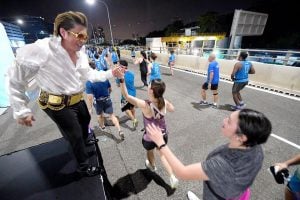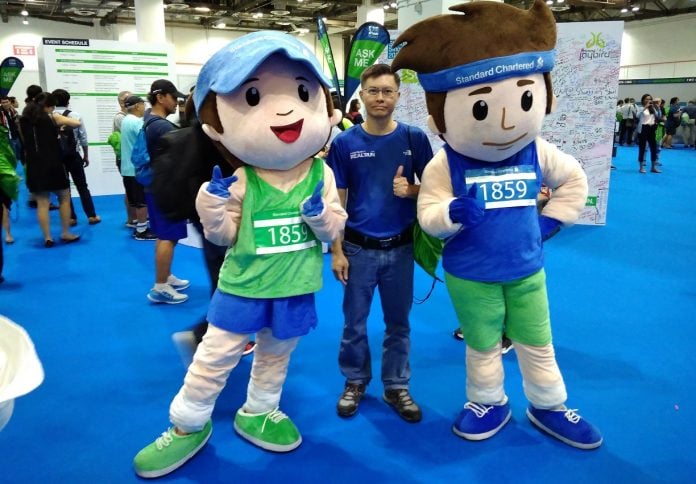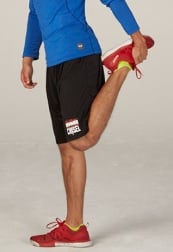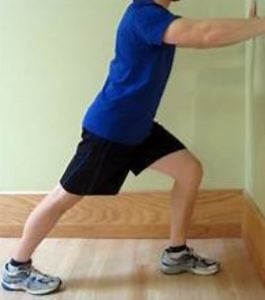Note: This race review is dedicated to those slow runners (7.3 min/km or more) and with knee pains, like myself, who want to try a FM but are holding back. However, please read with an objective mindset. What works for me may not work for you.
I was never keen to run a Full Marathon (FM). I do not consider myself an avid runner. So I believed that half marathon is the farthest distance I will run. Also, I have knee pains, which usually come in when I reach the 6 – 7 km mark. Running with knee pains in a full marathon is to me, at that time, was unthinkable.
Why I ran a FM?
Frankly, I was inspired by the late Uncle Chan. If Uncle Chan, despite starting late in running but completed numerous marathons before his passing, surely I should attempt at least once in my lifetime? Also, for a strenuous activity like FM, it is better that I should try it now rather than later, as I am already in my mid 40s. Who knows what happens in the future?
Why SCSM?
Standard Chartered Singapore Marathon (SCSM) is the best race in Singapore if you want to attempt the HM/FM. It is well organized and is the only IAAF Gold Label Road Race in Singapore. It is the only race where you can run in locations usually not quite possible as major road closures are planned and approved. It was also the race where I first did my half marathon in 2017. So it makes sense to do my maiden FM in SCSM after 2 years.
Set Realistic Goals
As a slow runner, I have to set realistic goals. I did not want to set high expectations to stress myself during the run. Enjoy the run, don’t feel stress!
Goal #1: Complete the Marathon, regardless of timing
Goal #2: Complete the Marathon within cut-off time of 7:30 hr
Goal #3: Complete the Marathon in less than 7 hrs.
But most importantly, my priority is: Go home safely with no injuries, regardless if I am able to complete the FM. It is all right to DNF. At most, try again the next time.
Considerations
Full marathon is twice the distance of half marathon. So running a FM will need more than just running regularly. I need to condition myself for the gruelling distance. I need to consider factors such as hydration, refuel needs, apparels and even the meals to take before the FM. Most importantly, I need to find out how to arrest my knee pains when the first symptoms surfaced and prevent muscle cramps along the run. Thus, I started training as early as August not only for endurance, but also to find out the solutions to each of the factors mentioned above.
Dealing with Knee Pain
I tried a few methods to prevent knee pains during running. This included doing stretching or exercises recommended by the ‘experts’ in Youtube and advice from runners. I also tried wearing knee guards during my runs, in the hope that the added stability and said improved blood circulation will alleviate this problem.
From my 4 months of evaluation, I found this works for me:
1) During the first symptom of knee pain, slow down and stop. Do not go on running.
2) Perform both quad stretching and calf stretching. I put more emphasis on quad stretch as it is an effective way to prevent knee pain.
You may read here for more information: https://www.knee-pain-explained.com/quadricep-stretches.html
3) I usually take a minute or so to perform the above stretching during each stoppages before I continue running. And once I hit 7 km, the frequency of these stoppages actually increases.
4) It will be difficult to regain my momentum if I am running at a fast pace after so many breaks. Hence I decided to reduce my pace so that I will have no issue to resume my pace after each stop. For a 10 km run, I am able to run at 7 min/km. For the purpose of the FM, I actually deliberately slowed to 8.4 min/km. It is a ‘stroll in the park’ pace.
In summary, once you encounter knee pains, stop and perform stretching immediately. Do not wait till another few hundred meters as the pain will probably worsens.
Training Regime
I am not a keen runner, so I decided to train just twice a week – a short run (3 – 5 km) during weekday and a long run during weekend. For the long run, I planned to progressively increase my mileage by 7 km after every 3 weeks. This worked out that I would have the endurance to manage at least 28 km run 2 weeks before the SCSM. The last 2 weeks were for my body to rest and I covered only short runs in order not to lose the momentum.
From what I understand from veteran runners, I believe that my training regime was not adequate for the FM. Many advocated running at least 3 times a week and hitting a weekly mileage of at least 40 – 60 km. Their training also included short sprints to build up core muscles. Some also signed up for long distance races leading up to SCSM as part of their preparation.
I had derived at mine so that I do not lose interest along the way. Base on experience, I will definitely suffered ‘burn-out’ if I over pushed myself. In my opinion, there is no ‘best training plan’, as this really depends on individual’s discipline, interest and what he/she wants to achieve in the FM.
Energy Replenishment
Energy gels had always been recommended to be consumed during runs as a mean of taking in carbohydrates. During my training, I consumed 1 packet at every 7 km (45 mins interval). During the FM, I found the most effective replenishment is actually the consumption of real food, such as banana. My stomach ‘crunched’ when I reached 23 km mark and could hardly continue until I ate bananas available at the next hydration station. It is difficult to go on with an empty stomach and I think no gel, which is chemically derived, can overcome this.
Water and isotonic drinks were provided during the run. Personally, I prefer the isotonic drink as it is important to replace loss of electrolytes to prevent cramps. Drinking too much water makes my stomach ‘bloated’ and uncomfortable to run.
You may read up here: https://www.runnersworld.com/advanced/a20814001/marathon-race-day-nutrition-and-hydration/
Pre-Marathon Diet
It is important as the race day looms near, you have decided on a diet or meals which provide you the nutrition you need. I did not specifically have a special pre-marathon diet as I am very particular about my food!
However, I do ensure I do not consume spicy food or curry at least one day before the race. On actual race day, I will take rice as I found it was able to sustain me from going hungry early. Again, diet and meals are individual’s preference. A top local runner claims he consumes a lot of pizzas and pasta just before his marathon!
You may read up here: https://www.healthxchange.sg/food-nutrition/food-tips/what-eat-before-during-after-race
Apparels
Singapore’s weather is hot and humid. You need to be comfortable with what you are wearing during the race. When I started participating in races, I wore mostly shirts with sleeves. As I progress on, I now wear singlets as they allow heat to dissipate and thus keep my body cooler during the run. Marathon is a long distance. Wear the attire which suits you best and you have to determine this during your training.
Do not feel pressured to wear the event shirt. Many of these shirts are not dri-fit. Look at those elite runners – how many of them actually wear the event shirts?
SCSM 2019
This year is the first time SCSM is organized as an evening race. One of the reasons I read is the Sports Officials and IRONMAN Asia are trying to get SCSM listed as one of the Abbott World Marathon Majors.
The event spanned across 3 days:
Day 1 (29 Nov) – The Kid’s Dash category
Day 2 (30 Nov) – The HM, FM and Ekiden categories
Day 3 (1 Dec) – The 5 km and 10 km categories
The FM race route was similar to last year’s edition, bringing the runners through the Central Business District, West Coast Highway, East Coast Park, Marina Bay Golf Course and finally finished at the Float @ Marina Bay.
Apart from the CBD area where there were pockets of spectators cheering on the runners, many parts of the route were rather monotonous. This is not new to local runners and I wondered how this can be improved.
Plus Points
1) Bag deposits and retrieval were efficient. A big transparent bag, which was included in the race pack, was used to store our possessions. All we need was paste the bib sticker onto the bag and hand it over to the crew.
2) Provision of hydration was adequate at every 2 km of the route. All stations provided water and most provided 100Plus as well.
3) There were many medical aid stations along the route which could provide needed medical attention to the runners if necessary.
4) Portable lights were used to provide additional light to some parts of the routes which were not well lit.
5) Performers were engaged to hype up the atmosphere throughout the run. Some even continued to perform for us slower runners to the tune of 1 am. 
Photo source: Singapore Marathon Facebook
Minus Points
1) The flag off times for half and full marathons were the same, resulting in congestion even though it was a rolling start. In my opinion, the HM and FM runners could each have started off one hour apart.
2) The Security Officers at the race village were rather strict when they told runners to vacate from the premises. While I understand they wanted to clear the area to prepare for Sunday morning’s runs, I felt they could have handled things better. The runners had just completed a grueling long distance race and naturally needed space to rest. Perhaps a separate tent/area could have been setup where the runners can comfortably rest.
Feedback from Public
There have been much backlash from the general public who were affected by the road closures. Perhaps IRONMAN Asia or the relevant authorities could have been more effective in communicating these road closures before the race. It is not easy to have a race in the heart of the city, passing the iconic landmarks and at the same time, ensuring minimal disruptions and inconvenience to the road users. This is a fine balancing act which the authorities have to consider before giving the green light for an evening race.
My Finishing Time
I completed my first FM in 7:34:31 hr, exceeding the cut-off time by 4 mins.
Although this is not a good result to shout aloud, I took pride that I completed the FM and it was definitely a memorable experience for me. As one veteran runner puts it: “The miracle isn’t that I finished. The miracle is that I had the courage to start.”
I thus conclude by saying that if doing a full marathon is your dream and if it is within your means, albeit you may have certain constraints, do really consider how to achieve that dream by finding solutions to remove your constraints.




